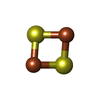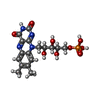+Search query
-Structure paper
| Title | Structural insight on the mechanism of an electron-bifurcating [FeFe] hydrogenase. |
|---|---|
| Journal, issue, pages | Elife, Vol. 11, Year 2022 |
| Publish date | Aug 26, 2022 |
 Authors Authors | Chris Furlan / Nipa Chongdar / Pooja Gupta / Wolfgang Lubitz / Hideaki Ogata / James N Blaza / James A Birrell /    |
| PubMed Abstract | Electron bifurcation is a fundamental energy conservation mechanism in nature in which two electrons from an intermediate-potential electron donor are split so that one is sent along a high-potential ...Electron bifurcation is a fundamental energy conservation mechanism in nature in which two electrons from an intermediate-potential electron donor are split so that one is sent along a high-potential pathway to a high-potential acceptor and the other is sent along a low-potential pathway to a low-potential acceptor. This process allows endergonic reactions to be driven by exergonic ones and is an alternative, less recognized, mechanism of energy coupling to the well-known chemiosmotic principle. The electron-bifurcating [FeFe] hydrogenase from (HydABC) requires both NADH and ferredoxin to reduce protons generating hydrogen. The mechanism of electron bifurcation in HydABC remains enigmatic in spite of intense research efforts over the last few years. Structural information may provide the basis for a better understanding of spectroscopic and functional information. Here, we present a 2.3 Å electron cryo-microscopy structure of HydABC. The structure shows a heterododecamer composed of two independent 'halves' each made of two strongly interacting HydABC heterotrimers connected via a [4Fe-4S] cluster. A central electron transfer pathway connects the active sites for NADH oxidation and for proton reduction. We identified two conformations of a flexible iron-sulfur cluster domain: a 'closed bridge' and an 'open bridge' conformation, where a Zn site may act as a 'hinge' allowing domain movement. Based on these structural revelations, we propose a possible mechanism of electron bifurcation in HydABC where the flavin mononucleotide serves a dual role as both the electron bifurcation center and as the NAD reduction/NADH oxidation site. |
 External links External links |  Elife / Elife /  PubMed:36018003 / PubMed:36018003 /  PubMed Central PubMed Central |
| Methods | EM (single particle) |
| Resolution | 2.3 - 2.8 Å |
| Structure data | EMDB-13199, PDB-7p5h: EMDB-13254, PDB-7p8n: EMDB-13257, PDB-7p91: EMDB-13258, PDB-7p92: |
| Chemicals |  ChemComp-SF4:  ChemComp-FES:  ChemComp-FMN:  ChemComp-ZN:  ChemComp-HOH: |
| Source |
|
 Keywords Keywords | OXIDOREDUCTASE / Hydrogenase / bifurcation / confurcaction / cryoEM / electron transfer / complex |
 Movie
Movie Controller
Controller Structure viewers
Structure viewers About Yorodumi Papers
About Yorodumi Papers












 Thermotoga maritima MSB8 (bacteria)
Thermotoga maritima MSB8 (bacteria)